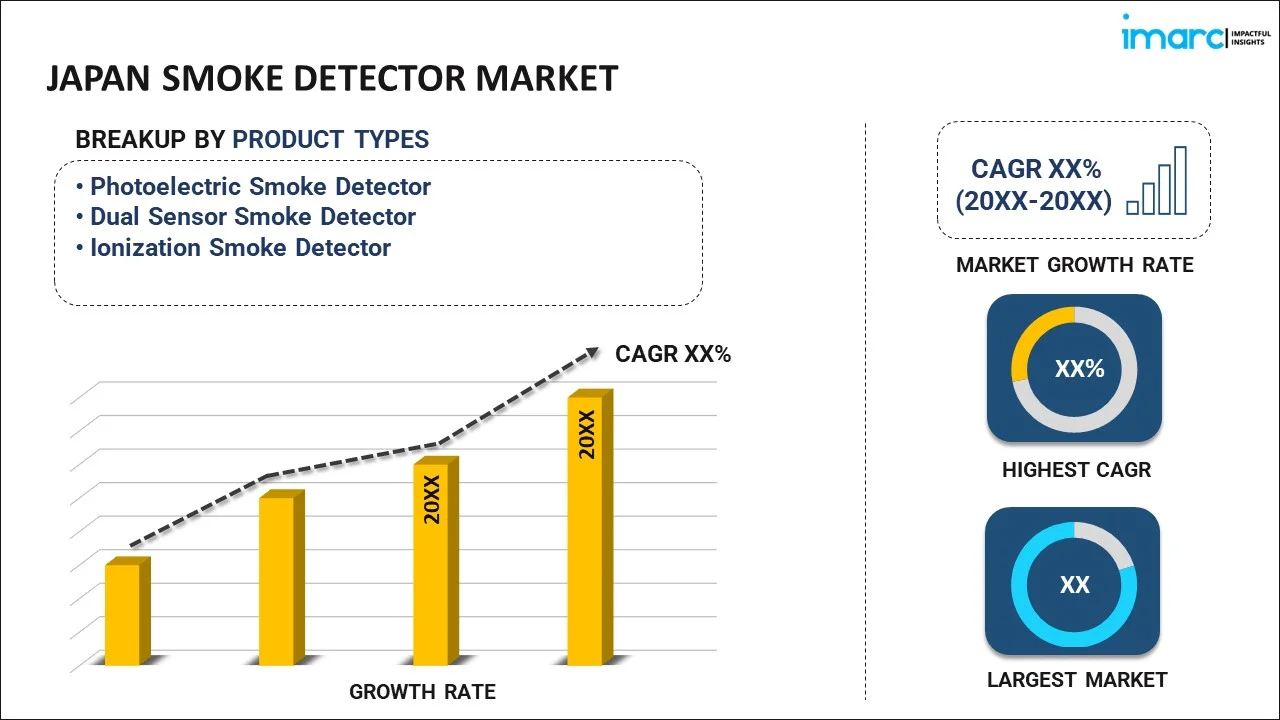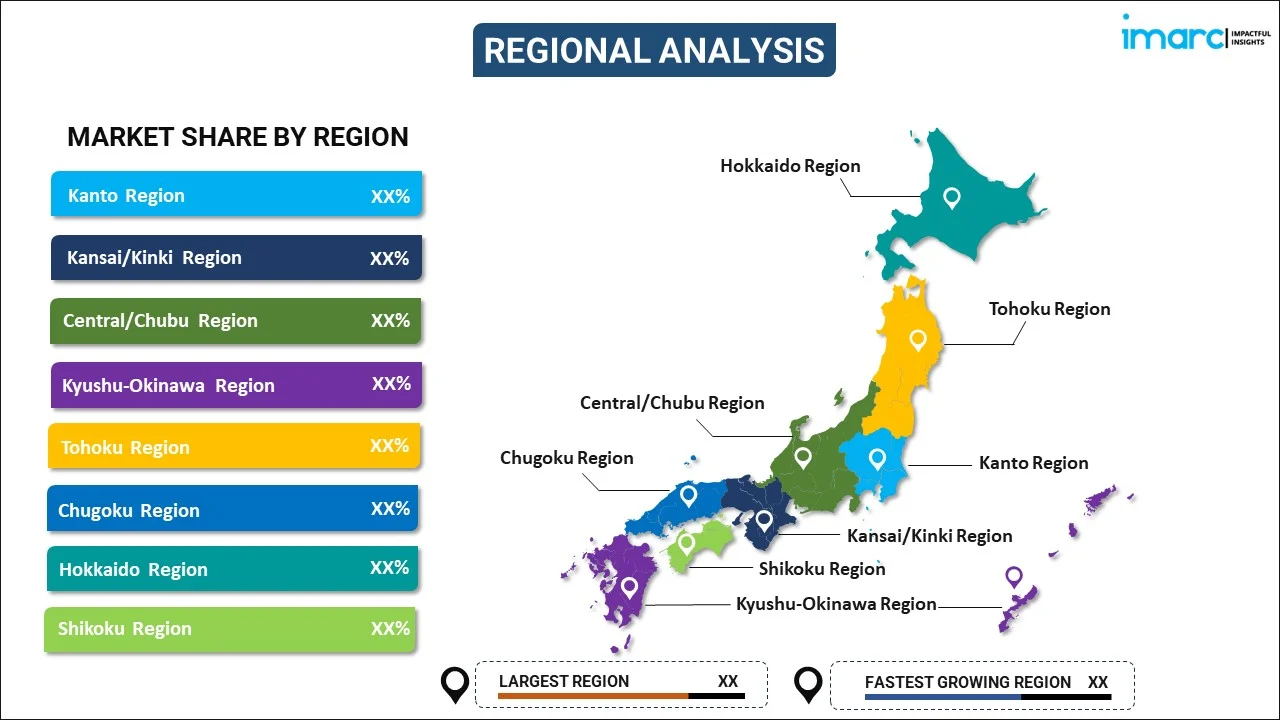
Japan Smoke Detector Market Report by Product Type (Photoelectric Smoke Detector, Dual Sensor Smoke Detector, Ionization Smoke Detector), Power Source (Hardwired with Battery Backup, Hardwired without Battery Backup, Battery Powered), End Use Sector (Oil, Gas and Mining, Residential, Commercial, Transportation and Logistics, Manufacturing, Telecommunication, and Others), and Region 2025-2033
Market Overview:
Japan smoke detector market size reached USD 81.4 Million in 2024. Looking forward, IMARC Group expects the market to reach USD 155.3 Million by 2033, exhibiting a growth rate (CAGR) of 6.8% during 2025-2033. The market is being driven by several significant factors, including the rising occurrences of residential fires, increased installations in locations such as airports, hospitals, and buses, and the expanding utilization in industrial facilities and other commercial buildings.
|
Report Attribute
|
Key Statistics
|
|---|---|
|
Base Year
|
2024 |
|
Forecast Years
|
2025-2033
|
|
Historical Years
|
2019-2024
|
| Market Size in 2024 | USD 81.4 Million |
| Market Forecast in 2033 | USD 155.3 Million |
| Market Growth Rate (2025-2033) | 6.8% |
A smoke detector is a specialized device engineered to detect the presence of smoke, usually serving as an indicator of a fire. It is considered a crucial component in fire prevention and is frequently mandated by building codes and regulatory standards. Its primary function is to trigger an audible or visual alarm directly from the device or transmit an alert to a control panel or a smart device, depending on its specific design. By delivering an early warning of a potential fire, it enables individuals to promptly evacuate the premises or address the fire in its initial stages. Smoke detectors are commonly installed in various settings, including residential, commercial, and industrial spaces, to enhance overall safety and fire preparedness.
Japan Smoke Detector Market Trends:
In the context of the Japanese market, several key factors are propelling the smoke detector market. Foremost among these is the significant expansion of the residential sector on a global scale. Many newly constructed residential properties are required to adhere to their respective country's building codes, which mandate the incorporation of smoke detection systems. The market is further accelerated by the increasing adoption of automation, concurrent with the rapid urbanization and improved living standards of the population. Additionally, the corporate sector widely deploys these systems to mitigate fire-related risks, bolstering market growth. Notably, the adoption of photoelectric smoke detectors is on the rise across various industries due to their ability to detect smoke more rapidly compared to ionization alarms. Furthermore, the introduction of high-performance smart smoke detectors is providing a significant boost to the market. These advanced variants notify users through smartphones when an alarm is triggered and feature self-testing capabilities to monitor battery status and keep users informed. Moreover, these devices are being integrated with cutting-edge Z-Wave technology, which is anticipated to propel the regional market over the forecasted period.
Japan Smoke Detector Market Segmentation:
IMARC Group provides an analysis of the key trends in each segment of the market, along with forecasts at the country level for 2025-2033. Our report has categorized the market based on product type, power source, and end use sector.
Product Type Insights:

- Photoelectric Smoke Detector
- Dual Sensor Smoke Detector
- Ionization Smoke Detector
The report has provided a detailed breakup and analysis of the market based on the product type. This includes photoelectric smoke detector, dual sensor smoke detector, and ionization smoke detector.
Power Source Insights:
- Hardwired with Battery Backup
- Hardwired without Battery Backup
- Battery Powered
A detailed breakup and analysis of the market based on the power source have also been provided in the report. This includes hardwired with battery backup, hardwired without battery backup, and battery powered.
End Use Sector Insights:
- Oil, Gas and Mining
- Residential
- Commercial
- Transportation and Logistics
- Manufacturing
- Telecommunication
- Others
The report has provided a detailed breakup and analysis of the market based on the end use sector. This includes oil, gas and mining, residential, commercial, transportation and logistics, manufacturing, telecommunication, and others.
Regional Insights:

- Kanto Region
- Kansai/Kinki Region
- Central/ Chubu Region
- Kyushu-Okinawa Region
- Tohoku Region
- Chugoku Region
- Hokkaido Region
- Shikoku Region
The report has also provided a comprehensive analysis of all the major regional markets, which include Kanto Region, Kansai/Kinki Region, Central/ Chubu Region, Kyushu-Okinawa Region, Tohoku Region, Chugoku Region, Hokkaido Region, and Shikoku Region.
Competitive Landscape:
The market research report has also provided a comprehensive analysis of the competitive landscape. Competitive analysis such as market structure, key player positioning, top winning strategies, competitive dashboard, and company evaluation quadrant has been covered in the report. Also, detailed profiles of all major companies have been provided.
Japan Smoke Detector Market Report Coverage:
| Report Features | Details |
|---|---|
| Base Year of the Analysis | 2024 |
| Historical Period | 2019-2024 |
| Forecast Period | 2025-2033 |
| Units | Million USD |
| Scope of the Report | Exploration of Historical Trends and Market Outlook, Industry Catalysts and Challenges, Segment-Wise Historical and Future Market Assessment:
|
| Product Types Covered | Photoelectric Smoke Detector, Dual Sensor Smoke Detector, Ionization Smoke Detector |
| Power Sources Covered | Hardwired with Battery Backup, Hardwired without Battery Backup, Battery Powered |
| End Use Sectors Covered | Oil, Gas and Mining, Residential, Commercial, Transportation and Logistics, Manufacturing, Telecommunication, Others |
| Regions Covered | Kanto Region, Kansai/Kinki Region, Central/ Chubu Region, Kyushu-Okinawa Region, Tohoku Region, Chugoku Region, Hokkaido Region, Shikoku Region |
| Customization Scope | 10% Free Customization |
| Post-Sale Analyst Support | 10-12 Weeks |
| Delivery Format | PDF and Excel through Email (We can also provide the editable version of the report in PPT/Word format on special request) |
Key Questions Answered in This Report:
- How has the Japan smoke detector market performed so far and how will it perform in the coming years?
- What has been the impact of COVID-19 on the Japan smoke detector market?
- What is the breakup of the Japan smoke detector market on the basis of product type?
- What is the breakup of the Japan smoke detector market on the basis of power source?
- What is the breakup of the Japan smoke detector market on the basis of end use sector?
- What are the various stages in the value chain of the Japan smoke detector market?
- What are the key driving factors and challenges in the Japan smoke detector?
- What is the structure of the Japan smoke detector market and who are the key players?
- What is the degree of competition in the Japan smoke detector market?
Key Benefits for Stakeholders:
- IMARC’s industry report offers a comprehensive quantitative analysis of various market segments, historical and current market trends, market forecasts, and dynamics of the Japan smoke detector market from 2019-2033.
- The research report provides the latest information on the market drivers, challenges, and opportunities in the Japan smoke detector market.
- Porter's five forces analysis assist stakeholders in assessing the impact of new entrants, competitive rivalry, supplier power, buyer power, and the threat of substitution. It helps stakeholders to analyze the level of competition within the Japan smoke detector industry and its attractiveness.
- Competitive landscape allows stakeholders to understand their competitive environment and provides an insight into the current positions of key players in the market.
Need more help?
- Speak to our experienced analysts for insights on the current market scenarios.
- Include additional segments and countries to customize the report as per your requirement.
- Gain an unparalleled competitive advantage in your domain by understanding how to utilize the report and positively impacting your operations and revenue.
- For further assistance, please connect with our analysts.
 Inquire Before Buying
Inquire Before Buying
 Speak to an Analyst
Speak to an Analyst
 Request Brochure
Request Brochure
 Request Customization
Request Customization




.webp)




.webp)












